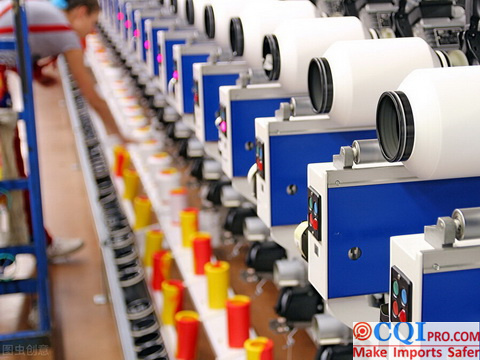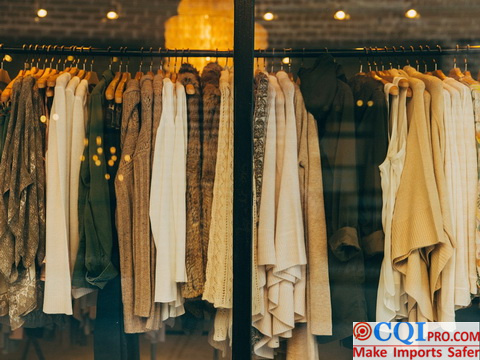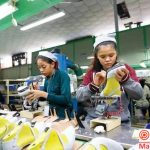China Textile Industry Transfer Trend and Southeast Asia Dilemma
In September 2020, the Chinese authorities said they would coordinate layout and development of the textile industry at home and abroad.
The background of this statement is that in recent years, part of the production capacity of the country’s textile industry has been shifting to Southeast Asia. According to statistics, Vietnam’s textile and garment exports increased by 7.5% year-on-year in 2019. In contrast, from January to December 2019, the cumulative exports of textiles and garments in China amounted to 271,836.2 million U.S. dollars, down 1.89% year-on-year.

CQI’s in-depth understanding reveals that there is indeed a transfer of textile and garment production capacity to Southeast Asia, mainly in the piece of spinning and garment production. Among them, ready-made garment production is not high technology, low value-added, more dependent on the advantages of low labor costs in Southeast Asia, while most of the spinning is the transfer of Chinese domestic production capacity. 2019, Chinese investment in Vietnam spinning capacity accounted for 32% of Vietnam’s total spinning capacity.
However, many Chinese textile companies have invested in factories in Southeast Asia, and will face the challenge of an imperfect industrial chain while enjoying cost dividends. “The wages of workers in Myanmar are particularly low, only $400-500 per month, but the raw materials all need to be imported from China, adding additional logistics costs. And in addition to logistics costs, there are also these uncontrollable factors in transportation, such as logistics delays, lost and damaged goods, etc. These are all headaches and thorny issues.” The general manager of a Myanmar garment company once said this.

A part of the garment companies also have a new choice, is to move factories to China’s central and western. Because in recent years a number of central and western textile industrial park was built, showing that China’s textile industry is accelerating to the central and western transfer. In Sichuan, for example, since 2020, including Luzhou, Zigong and other places are related to the construction of industrial parks, local textile production capacity was significantly enhanced. For garment enterprises, this is undoubtedly a great news. At least they don’t have to worry about the language barrier. CQI’s inspectors also have more oppotunities to show their abilities, since the change of China’s textile policy is aimed at promoting the overall development of enterprises and the local economy.
China Textile Industry,Plight Of Industrial Chain In Southeast Asia
The export value of the textile and garment industry in many Southeast Asian countries has continued to maintain a rapid growth of more than 5% in recent years. This is because they have benefited from the transfer of the textile and apparel industry, so their exports are growing faster. Vietnam, for example, exported $32.6 billion in textiles in 2019, up 7.5% from 2018 and 24.42% from 2017.
Behind this, the fact is that many Chinese companies have set up factories in Southeast Asia. One company has been in the garment industry for 13 years and decided to move some of its production capacity to Myanmar in 2013. They moved the factory mainly for two reasons, first of all, the low wages of workers in Myanmar, and more importantly, at that time, the European Union gave Myanmar the most favorable country policy and zero tariff for Myanmar’s products exported to the EU. The lure of low wages and zero tariffs in Southeast Asia has prompted many Chinese textile companies to move.
A factory in cooperation with CQI has been engaged in the textile and apparel industry since 1993, mainly producing products such as handbags, luggage and belts, with the U.S. as its main overseas market, and in 2018 they began building a factory in Cambodia, shifting most notably to avoid tariffs. Next and heard that many listed companies also choose to set up factories in Southeast Asia. Southeast Asia, mainly Vietnam, with low cost (labor, water and electricity) and policy support (low tax), is indeed an advantage for the development of the textile and garment industry. In addition, Vietnam has joined a number of free trade agreements, its textile and apparel goods tariff threshold further reduced.
However, unlike large enterprises that can set up a number of upstream industrial chain enterprises and projects at the same time, small and medium-sized textile enterprises are trapped in an incomplete industrial chain after setting up factories in Southeast Asia. Because the industrial chain in Southeast Asia is not mature and can only do OEM products, small and medium-sized enterprises need to purchase raw materials in China and ship them to Myanmar for processing into garments for export. In addition, the productivity of Cambodian workers is low,skilled workers’s productivity are only 60% of the domestic, and even the management staff has to be employeed from China. He also spent nearly a year on training Cambodian workers to adapt to the production management of the garment factory.
China Textile Industry’s Practical Case
To give a simple example: the cost of the product delivered to the customer is lower than in China, for example, the cost of production in China is US$10, because of the tariff, it is US$14.3 when it reaches the customer, while the cost of production in Cambodia is about US$11. However, just from the production side, the overall production cost in Cambodia is higher than in China because of the raw materials need to be imported from China, which generates logistics costs.
So the trap of the industrial chain, resulting in not all Chinese textile companies are suitable to move to Southeast Asia. Another old customer of CQI which located in China’s Guangdong Province and has been in the textile industry for 12 years,in order to expand production and reduce labor costs, it visited Vietnam 2 years ago, but finally decided to still keep its production capacity at home. The inspectors found that large enterprises are more complete in all aspects of the supply chain, from manufacturing, printing and dyeing to ready-made garments, but it is difficult for small businesses like theirs to move there, and they also lack capital.
Language barrier, etc. is also a problem that Chinese companies must face. You have to hire an interpreter for everything, thus incurring a lot of labor and time costs. Secondly, it is very slow to register a company in Cambodia, at least 4-6 months, while it only takes 10 days in China.
With the improvement of domestic and foreign consumption levels and the change in business models of enterprises, the demand for inspection at home and abroad has risen and increased in order to promote sustainable development and improve product quality. Many importers also realize that product inspection plays a very important role in controlling product quality to a certain extent. It is not just because we provide inspection services that we are pushing the importance of product quality. Rather, we want to analyze the negative and positive effects of product quality from the root and give importers from all over the world some references to avoid unnecessary losses.
China Textile Industry Supports Industrial Transfer.
At present, the flow of orders to Southeast Asian countries is also an important reason for forcing Chinese textile enterprises to move to Southeast Asia. Some importers are more supportive of running factories in Myanmar, and some importers place orders with a statement that they must be produced in Southeast Asia. However, more orders do not mean more profits, when more and more Chinese textile enterprises pile up in Southeast Asia, the competition between enterprises is gradually escalating.
Most of the Chinese-owned factories in Myanmar do not make much profit, and only a small number of better-managed factories may be more profitable. From the perspective of processing factories, it is already good to make a few million yuan a year with an investment of tens of millions of yuan. There are even factories that choose to take orders even if they are money-losing orders, in order to support local workers. Since this is the case, how do Chinese textile companies to choose a reasonable layout in China and Southeast Asia?
In response to this problem, the Chinese government supports textile and garment enterprises to accelerate technological transformation, improve automation and intelligence, support the transfer of textile and garment industries to the central and western of the country, guide standardized enterprises to carry out international production capacity cooperation in an orderly manner, promote the positive interaction between international cooperation and domestic industrial upgrading, and stabilize and optimize the textile industry chain and supply chain.
So, the textile and garment industry to the Midwest, will it be the choice of enterprises? After investigation, we found that there are indeed textile and garment enterprises that have opened factories in Southeast Asia are considering this issue. Because whether it is factories in Southeast Asian countries like Myanmar and Vietnam, or factories in China, there are well run and badly run. China’s domestic like Guangxi, Xinjiang and Shandong, there are also less than 3,000 yuan wages.

The Future Trend of China Textile Industry
The competitive advantage of China’s textile and garment industry is mainly reflected in the better matching of the whole industrial chain and the high-quality textile skilled workers in China. Especially, with the policy control of China’s cotton reserves this year, the price difference between domestic cotton and foreign cotton keeps running at a low level, and the cost performance of domestic cotton is improved, thus the cost advantage of Chinese cotton yarn is reflected again. But for the whole world textile raw materials, cotton fiber only accounts for about 25%, and most of them are contributed by chemical fibers such as polyester staple fiber and viscose fiber. At this point, China has an absolute advantage in chemical fiber production capacity, and the textile industry chain is more perfect.
One of the current difficulties lies in the gradual increase in the cost of production factors, the second difficulty lies in the foreign trade market by the impact of trade barriers is gradually increasing. Textile and garment industry does exist to the phenomenon of the transfer of China’s central and western, but this is still difficult to solve the problem of trade barriers, the advantages of Southeast Asia do exist. Because of the textile and garment system, industry chain supporting the huge advantages of the Chinese textile and garment industry in the global trade is still difficult to shake the position. Although the spinning capacity gradually transferred to Vietnam, but the main export of Vietnamese cotton yarn still lies in the Chinese market, and imports of synthetic yarn mainly from China, it seems that the Vietnamese textile industry is more like a supplement to the Chinese industry.
CQI believes that there is still room for breakthroughs in the Chinese apparel industry chain. The current apparel industry is polarized, one kind of apparel companies like H&M and UNIQLO, with good quality and low price and large volume, can take advantage of the cost. The other is a small amount and fashionable, seasonal, China’s supply chain is quite mature in order to produce. We look forward to the subsequent development of China’s textile industry, whether in Southeast Asia or China, the perfection of the industrial chain is the basis for its development.
CQI5 is committed to providing importers worldwide with product quality inspection services that far exceed those of our peers. If you are planning to import or have imported from China or Southeast Asian countries, please contact us cs’@’cqipro.com to learn more about how we can make your imports safer.
This article is an original article for CQI Inspection, who is committed to providing high-quality product inspection technology and know-how sharing for global importers and retailers to make imports safer.
All rights reserved. The contents of this website provided by CQI Inspection may not be reproduced or used without express permission.
For reprint, please contact with CQI Inspection, thank you.





